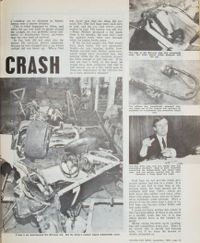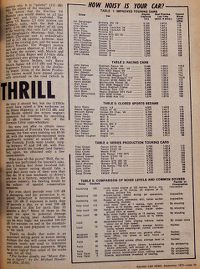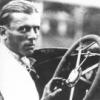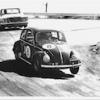This thread has raised several interesting safety issues: the development and use of the six-point restraint system, the reason(s) for the death of Jochen Rindt, the safety of Lotus racing cars, and the general philosophy of risk acceptance. I will comment on each, but not all at once, for fear of boring everyone to death.
First, then, the six-point harness and the death of Jochen Rindt.
In relevant summary, the history of seat belts is as follows. In 1903 a French patent was issued for a system of seat belts and upper torso restraint. The concept was applied to aircraft before, during and after WW1, but to stop pilots falling out, not for crash protection.
Colonel John Paul Stapp in the late 40s was among the first to document the potential for aircraft restraint systems to increase human injury tolerance. He noted that what he called an “inverted V strap” could balance shoulder-belt loads and keep the lap belt in place.
In 1955, Stapp and others began to promote seat belts for motor vehicles, mainly through their effect in preventing ejection, and they began to be fitted to road cars.
In racing, however, ejection was widely regarded as a good thing, contrary to the emerging research on road car crash research. During the 50s, some drivers of sprint cars in America were using rudimentary lap belts and Sam Browne shoulder straps, but simply to keep them in their seats during the racing. Protection by the belts was at first not an issue, but became one in the 60s when some European drivers at Indianapolis objected to their mandatory use.
In Europe, as late as 1967 practically no driver in any category was wearing a restraint system in an open car. Two exceptions were Max Mosley and me, racing against each other in MallockU2s.
Early that year I had decided to get some real data to resolve the issue, and followed up 221 crashes in England, about 80% of those that were reported to the RAC. I came up with statistically significant evidence that it was far better to stay within a crashing race car, whether open or not, and even whether it rolled or not.
I also used my experience with a team working on combat aircraft harnesses and as a rescue parachutist to present the concept of crutch restraint using two additional straps, but not as an inverted V.
Their unique feature was that they were routed via the pubic bones and then outwards, returning to the buckle via D-rings. These additional straps had the twin advantages of balancing the load of the shoulder belts, thus preventing ride-up of the lap belt, and taking much of the crash loading through the pelvic bones. Drivers of formula and sports-racing cars were super-reclined, and the use of simple four-point lap-shoulder belts presented a real risk of “submarining”.
I think DCN may be able to confirm that I first published my crash and injury data in “Motor Racing” magazine. I then included them in a book that covered a lot of other considerations, “Motor Racing in Safety”.
Louis Stanley, whose work with the GP Medical Service I greatly admired, wrote the foreword, and having reviewed my figures in late 1967 told me one night at his home in Cambridge, “I’ll put belts in Stewart’s car”. The book was published by Pat Stephens in early 1968, just as I moved to Australia. JYS was very supportive, and by the end of 1968 every F1 driver, and the majority in all other categories, were using belts.
I met Jochen Rindt at Warwick Farm during the 1969-70 Tasman Series, and had the pleasure of a wonderful dinner with him, Nina, and Piers Courage. Rindt told me that he had read my book and had come to agree with using a harness. However, he could not come to terms with the use of the crutch straps, and I could not convince him that they would not cause harm to a young lad in a crash.
That the lack of crutch restraint, and the resulting submarining effect in frontal impact, was a factor (among others) in his death at Monza is well documented. Not so well documented (at least publicly) are the details of his injuries, but they certainly included injuries to his legs and neck.
The belt buckle caught him under his chin and may even have prevented his complete ejection. I would not be surprised if the lap belt had caused abdominal injuries including internal bleeding. Both Jackie Stewart and Louis Stanley have written extensively about how the GP Medical Service was by-passed, and I can’t comment further in the absence of detailed information on Jochen’s injuries and medical status.
There were crutch straps in the Lotus, but they were not secured. Most drivers were by then using the crutch restraint (and they probably all were, afterwards). I still feel personal regret that I was not able persuade either him or Jimmy Clark that a full six-point harness could be life-saving, with no real negative effects.
Enough! More later. As a teaser, I do have some data on the contribution of mechanical failure in F1 crashes from 1966 to 1972, sorted by chassis manufacturer, and I’ll post them when I have time.
It's my belief that there is a great deal to be learned about these events and how they contributed to the relative safety that came into racing at that time.
But I also believe that events in Australia need to be included in the narrative for the purpose of injecting some more pertinent information into the overall picture.
Michael mentions that he came to Australia early in 1968. He had taken up a post on the editorial team of the Medical Journal of Australia and continued his involvement in racing when he arrived.
His passion for the wearing of safety belts was to be the most public of his interests here, however.
In the May 1968 issue of Racing Car News a double spread story by him covered much the same ground as the story in Motor Racing the previous October, but with a couple of extra (and very topical) inclusions. This was the same issue of the magazine that carried the report on the Bathurst race meeting in which John Harvey was seriously injured and Leo Geoghegan less seriously so.
Neither had worn belts. The only cars practising that day with belts fitted were those of the Niel Allen team, Niel's McLaren M4a (to start from third on the grid) and Fred Gibson in the 2.5 FPF Brabham that Frank Gardner had raced in the 1967 Tasman. He was eighth on the grid.
However, according to Bill Tuckey's book, The Rise and Fall of Peter Brock, Harvey should have had them in his car. Tuckey wrote:
At the time there was an argument raging in motor racing about whether or not full harnesses should be worn. This was old stuff for Harvey; he had lived through the roll-bar and full harness arguments in speedway. Jackie Stewart, who would later spearhead (etc)... had been wearing full harness; Denny Hulme was arguing it was better to be chucked out of the car. The general feeling was against full harness; from his speedway days Harvey knew damn well it was better to stay with the car. He had been using full harness from the first day in the little F2 Brabham.
Harvey was still living in Sydney and the new car was being prepared in Mdelbourne. For Easter at Bathurst... they didn't get to Bathurst until Saturday night. Said Harvey: 'They rolled out the car on the Sunday morning, and I said: "Where's the belts?" They said: "We've got them, but we weren't sure where you wanted them fitted, and this cockpit's different to the last car. It's only a matter of drilling more holes and getting the adjustment right". The suggestion was that we practise without them and fit them that night for the race the next day and I said 'OK, my decision, I'll practise without them'.
I'm not so sure that Harvey had belts 'from the first day'... I'll have to find and check my photo of him on that 'first day' (sitting in the marshalling area at Lakeside with Peter Molloy alongside him waiting to go out for practice) before I'm convinced of that point.
As you'll read in Michael's RCN article Kevin Bartlett's car was fitted with belts that night, and that could well have been fortuitous as it had a similar suspension failure to Harvey's during the race the next day. Fortunately KB was able to keep it from crashing and merely retired from the event.


From this point there was really little movement towards 'belting up'... until Niel Allen crashed at Lakeside in July.



























